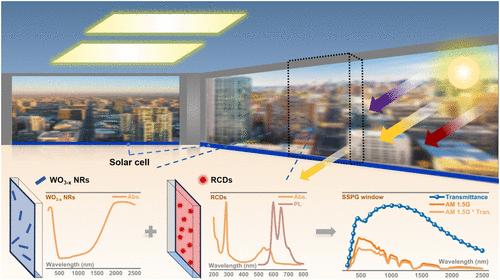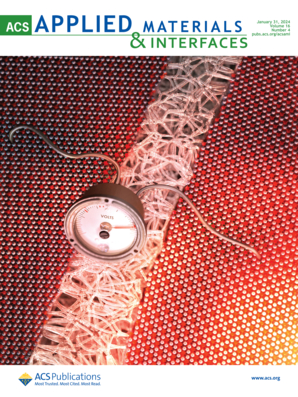Highly Transparent, Spectrally Selective Power-Generating Windows Based on WO3–x Nanorods and Carbon Dots for Full-Spectrum Utilization
IF 8.3
2区 材料科学
Q1 MATERIALS SCIENCE, MULTIDISCIPLINARY
引用次数: 0
Abstract
Near-infrared (NIR) shielding windows can selectively regulate excess solar radiation to reduce heating and cooling energy consumption in a built environment. However, the dissipation of ultraviolet (UV) and visible light into waste heat is inevitable, leading to inefficient solar energy utilization. Herein, a tandem spectrally selective power-generating (SSPG) window is developed by incorporating oxygen-deficient tungsten oxide WO3–x nanorod-based NIR shielding windows and red-emissive carbon dot-based luminescent solar concentrators (LSCs) to realize full-spectrum utilization. Semitransparent NIR shielding modules absorb NIR light to reduce indoor thermal radiation, while a semitransparent LSC coupled with a photovoltaic system converts UV and partially visible light into electricity. The SSPG window exhibits a visible light transmittance of up to 70.44% and power conversion efficiency of 0.31%, while effectively reducing the indoor temperature by 7 °C under sunlight irradiation. In addition, this SSPG window has good thermal-/photostability and excellent NIR shielding performance after heat treatment and UV irradiation. This work may provide a new avenue for the development of energy-saving windows.

求助全文
约1分钟内获得全文
求助全文
来源期刊

ACS Applied Materials & Interfaces
工程技术-材料科学:综合
CiteScore
16.00
自引率
6.30%
发文量
4978
审稿时长
1.8 months
期刊介绍:
ACS Applied Materials & Interfaces is a leading interdisciplinary journal that brings together chemists, engineers, physicists, and biologists to explore the development and utilization of newly-discovered materials and interfacial processes for specific applications. Our journal has experienced remarkable growth since its establishment in 2009, both in terms of the number of articles published and the impact of the research showcased. We are proud to foster a truly global community, with the majority of published articles originating from outside the United States, reflecting the rapid growth of applied research worldwide.
 求助内容:
求助内容: 应助结果提醒方式:
应助结果提醒方式:


